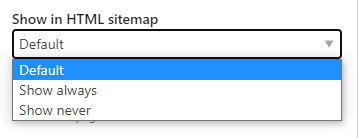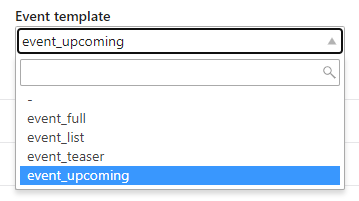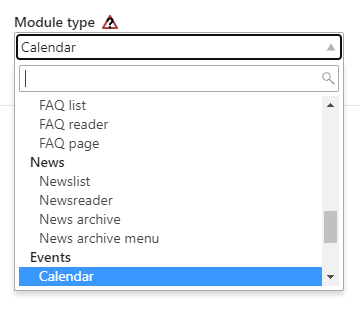Select Menu
This widget renders a drop-down menu.
A simple select menu with hard-coded options whether to show the current page in the HTML Sitemap:

A select menu enhanced with Chosen.js to allow the editor to limit the available options with a simple search box:

A grouped select menu enhanced with Chosen.js:

Options
This table only shows the options relevant to the core functionality of this widget. See the DCA reference for a full field reference.
| Key | Value | Description |
|---|---|---|
inputType |
select |
|
options |
array |
An options array (use in combination with eval.multiple) |
options_callback |
function|callable |
A callback function that returns the options callback or an array (use in combination with eval.multiple). You may define an anonymous function, but you should consider registering them via annotations. |
reference |
array |
Reference an array that will be used to translate the options. Contao will automatically match the options and reference array by key. |
foreignKey |
string |
Reference another table to generate options from. |
eval.multiple |
true/false (default) bool |
Set this to true if you want to provide multiple options via options or options_callback |
eval.includeBlankOption |
true/false (default) bool |
Includes a blank option (useful in conjunction with mandatory fields) |
eval.blankOptionLabel |
string (default -) |
The label of the blank option |
eval.chosen |
true/false (default) bool |
Enhance the select menu with Chosen.js |
eval.disabled |
true/false (default) bool |
Disables the input field |
The options array – either set directly or returned by an options callback – can have different structures depending on what you are going for:
[ 'label1' , 'label2' ]where the values of the select options will be the regular array index.[ 'value' => 'label' ]wherevaluewill be the value of the select option, andlabelthe label.[ 'foo' => ['a', 'b'], 'bar' => ['c', 'd'] ]which will render grouped select optionsfooandbar.
Column Definition
Depending on the widget configuration, the widget persists different values to the database. You have to take care of the correct SQL column definition yourself. A single select will save the selected value as string. If you allow to select multiple options, they are stored as serialized array. Since you do not know the length in advance, a blob column is prefered.
Examples
If you simply want to select an option from a fixed set.
// ...
'isVisible' => [
'label' => ['Visibility', 'Whether this element is visible on the page'],
'inputType' => 'select',
'options' => ['always', 'never', 'auto'],
'sql' => [
'type' => 'string',
'length' => 8, // Must be large enough to store all possible values
'default' => 'auto',
],
],
// ...
If you simply want to select one option from a fixed set of grouped options.
// ...
'mySelect' => [
'label' => ['Select', 'Help text'],
'inputType' => 'select',
'options' => [
'news' => [
'news_reader',
'news_list',
],
'events' => [
'event_reader',
'event_list',
],
],
'sql' => [
'type' => 'string',
'length' => 16, // Must be large enough to store all possible options
'default' => '',
],
],
// ...
You can also dynamically generate the options array to filter them as you wish. See the options callback for further examples.
// ...
'mySelect' => [
'label' => ['Select', 'Help text'], // Or a reference to the global language array
'inputType' => 'select',
'options_callback' => [
'Vendor\Class', 'getMySelectOptions' // Defines a method that returns the options array. Class can be a service.
],
'eval' => [
'chosen' => true, // Adds a search box to filter the options
],
'sql' => [
'type' => 'string',
'length' => 16, // Must be large enough to store all possible options
'default' => '',
],
],
// ...
You can generate an options array from another table with the foreignKey property.
// ...
'myUsers' => [
'label' => ['My Users', 'Help text'], // Or a reference to the global language array
'inputType' => 'select',
'foreignKey' => 'tl_user.name', // Will use `name` as label, and the user `id` as value
'eval' => [
'chosen' => true, // Adds a search box to filter the options
],
'sql' => [
'type' => 'integer',
'unsigned' => true,
'default' => 0,
],
],
// ...
Usage in Contao
Basically everywhere, e.g. tl_page or tl_module